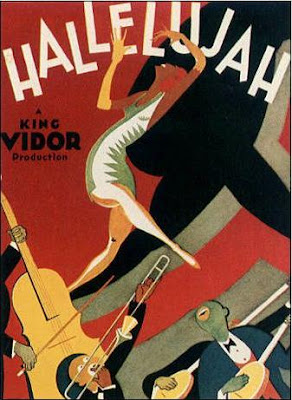Hallelujah (1929)
 Film director King Vidor for years had dreamt of producing a picture about an African-American sharecropper and his struggles, produced with an all black cast. Finally, in 1929, Vidor would convince the biggest studio in Hollywood, MGM, whom he was contracted with to allow him to produce this picture which would happen to be one of the quietest revolutions in motion picture history, a film years ahead of its time in both cinema and the civil right movement, and contrastingly at the same time cause absolutely no stir in the movies or America. Hallelujah! was that picture.
Film director King Vidor for years had dreamt of producing a picture about an African-American sharecropper and his struggles, produced with an all black cast. Finally, in 1929, Vidor would convince the biggest studio in Hollywood, MGM, whom he was contracted with to allow him to produce this picture which would happen to be one of the quietest revolutions in motion picture history, a film years ahead of its time in both cinema and the civil right movement, and contrastingly at the same time cause absolutely no stir in the movies or America. Hallelujah! was that picture.The story follows sharecropper Zeke Johnson (Daniel L. Haynes) and his moral struggles through life as he is continually tempted by the young, seductive scam artist by the name of Chick (Nina Mae McKinney. His roots in deeply religious sharecropping family, builds the base of the person he is, but when Chick enters his life he cannot help but fall under her spell, even though it ruins him and his family. His life is devistated by his attraction to Chick leading to events that include the accidental death of his brother and his temporary loss of faith after become a popular, well-respected preacher. Though Zeke turns his back on his family, his congregation, and even his faith to follow the seductions of this she-devil, he does right his path back to his roots, even after the event that leads to the death of Chick and her hustling lover/comrade. In the end it becomes a prodigal son type of story as he is welcomed back into the fold with open arms of this loving southern family.
Director King Vidor knew that this production was a gamble, as it would be one of the first movies by a major studio with an all black cast, not to mention it being a sound picture and a musical on top of that. Vidor would invest his own salary into the production to get it made. Intended to be made for wide release the picture was meant to manifest an honest treatment of African-Americans on film. Though the picture does have its moments of being condescending, which Vidor admitted years later that the film seemed a little guilty of, it is not full of stereotypes of African-Americans. Even DVDs of the picture open with disclaimers that the film is not politically correct, but this is a film made for its time, and that for its time it is a rather positive film towards blacks in America. Keep in mind that this was released just a little over 60 years after the Civil War freed countless slaves and Jim Crow laws were fresh in most everyone's mind. The film does a respectful job of producing a picture that would showcase lives of a people that most white American's did not fully understand. The sad part is their would be no follow up to this picture by Vidor, MGM, or anyone for that matter. It would sit as merely a blip on the radar in the overall time line of cinema history around the time before motion pictures hit its "golden age." It would be decades before an all-black cast would be in a serious major motion picture in mainstream America.
Hallelujah! was be a remarkable achievement in sound production in film as the picture utilized many tools of sound recording and mixing collectively with great success when sound was still in its infancy. The film was shot on location in parts of Arkansas and Tennessee as well as in studio, and sound was recorded inside, outside, and in post-production with both dialogue and musical numbers. You must understand how new and difficult it was back in those days to achieve these feats and then mix them in post-production so well that it would not be so noticeable in the jump in quality, ultimately producing a final picture with such great sound clarity making this film a very impressive achievement despite its cast or story.
With this film King Vidor would be nominated for Academy Award for best director. His most popular work would come in ten years when he would direct the black and white Kansas scenes from the MGM classic The Wizard of Oz. At age 16 Nina Mae McKinney shines on screen as the future star in this picture with her bright-eyed, energetic, yet seductive look. McKinney landed herself an MGM contract of 5 years starting with this film. Unfortunately for her by the end of the contract her star did not seem as bright as she would move back and forth between the US and Europe throughout her life performing on stage and in a select number of films.
Hallelujah! though just a small footnote in film history is one worth watching and noting, as it was a step in the right direction for African Americans in mainstream cinema. Even with it not directly leading to any real revolution in race relations in motion picture production, it is a stand alone good picture from its time period that shows us a piece of what America in a different time. (Even it it is Hollywood's version of it.)
.jpg)
.jpg)
Comments
Post a Comment